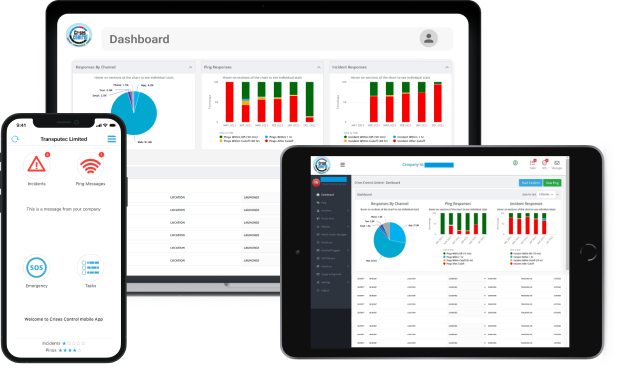Written by Anneri Fourie | Crises Control Executive
A Crisis Doesn’t Wait. Can Your Alerts?
In a crisis, real-time communication isn’t optional, it’s everything. A server crashes at two in the morning. A fire alarm sounds in an empty office. A field team receives a severe weather warning. In all these moments, how quickly you notify people can be the difference between chaos and control.
Traditional tools, emails, calls, WhatsApp, simply aren’t built for crises. Emails get buried, phone calls go unanswered. By the time critical information reaches the right people, it’s often too late. Delays can cost you time, money, reputation, and even endanger lives.
Many organisations already use Microsoft Teams for these scenarios. But can this everyday platform really become your lifeline when disaster strikes? With Crisis Alerts in Teams, the answer is yes.
Why Instant, Integrated Communication Matters
When a crisis erupts, uncertainty spreads faster than the incident itself. Rumour and panic fill the silence. That’s why the importance of instant communication during crises isn’t just a slogan, it’s a survival strategy.
Imagine initiating a mass email during a crisis. Out-of-office replies arrive, important recipients miss the message, and by the time inboxes clear, the situation has escalated. Or consider phone trees: if one person is unavailable, the chain collapses.
If you’re working remotely or across multiple sites, those delays compound. That’s why modern companies are turning to mass notification software for Teams real‑time crisis alerts, to cut through distractions and reach every stakeholder in moments.
Turning Teams into a Crisis Command Centre
On its own, Microsoft Teams is ideal for meetings and messaging, not emergencies. Crises Control enhances Teams with one crucial feature: priority push notifications and acknowledgement tracking.
With our integration, Microsoft Teams becomes the centre of your crisis response. Here’s what it looks like in practice:
-
- Instant alerts: Critical messages pop up in key Teams channels or private chats.
-
- Priority notifications: Messages are distinguished from standard chats, ensuring they grab attention.
-
- Acknowledgement tools: Recipients can confirm receipt with a simple tap like “I’m safe” or “I’m responding.”
How Real‑Time Communication Works in Microsoft Teams
Our integration creates a seamless workflow between alert and action. Here’s how it works:
Step 1: Incident Activation
An authorised user launches an alert manually, or it’s triggered automatically by your integrated monitoring systems (like server monitors or IoT sensors).
Step 2: Priority Alert Arrives in Teams
A high-priority push notification appears in Microsoft Teams. For total reliability, the same alert is sent via SMS, email, mobile push, and voice calls.
Step 3: Acknowledgement is Tracked in Real-Time
Recipients confirm they’ve seen the alert with a simple tap (“I’m Safe,” “I’m Responding”) directly within Teams. Crisis managers instantly see who is accounted for.
Step 4: The Smart Handoff to Action Plans
The Teams alert is for the immediate “what.” For the detailed “how,” users click a link that takes them directly to the relevant playbook (e.g., evacuation plans, technical checklists) in the secure Crises Control mobile or web app.
Step 5: Full Reporting and Analytics
Every action is logged and timestamped in Crises Control. Dashboards provide a complete overview for audit logs, compliance reporting (ISO 22301, GDPR), and post-incident analysis.
The Benefits of Crisis Alerts in Teams
Rapid Response
By integrating alerts into an everyday tool, your people don’t have to learn new apps. They react instantly, reducing response times by minutes, or even hours.
Guaranteed Delivery
Using multiple channels; Microsoft Teams, SMS, voice, mobile app alerts, and email, ensures no one misses a critical message, even if they’re offline or out of network range.
Real‑Time Visibility
Acknowledgements give crisis managers real-time insight into who’s aware, who’s missed the alert, and who needs follow-up.
Structured Guidance
While initial alerts and acknowledgement happen in Teams, the platform stores detailed action plans, ensuring consistent execution of incident workflows.
Compliance and Reporting
Complete logs and analytics built into Crises Control help with compliance standards like ISO 22301 and GDPR, and support future review and improvement.
Use Case Example: Cyber Incident Response
Let’s walk through a typical scenario:
3:15 AM: SIEM flags unusual activity, possible ransomware.
3:15 AM: Crises Control automatically triggers a “Severity 1 Cyber Alert.”
3:16 AM: Team receives an urgent push notification inside Microsoft Teams and SMS to their phones.
3:17 AM: Sarah, the on-call analyst, taps “I’m Responding” in Teams and follows a link to the ransom response playbook in the Crises Control app.
3:20 AM: Alert escalates to IT head and legal counsel, with a summary and next steps.
3:30 AM: The team has contained the incident, all orchestrated smoothly through notifications in familiar tools.
Another Example: Physical Safety Alert
Picture a chemical spill in a factory:
10:42 AM: The floor manager triggers a “Spill Emergency.”
10:43 AM: All employees get push notifications and SMS. Large-screen dashboards display evacuation instructions.
10:44 AM: In a dedicated Teams channel, a message appears: “Evacuated? Yes / No, need assistance.”
10:48 AM: Health & Safety managers see who is safe and who needs help, and direct emergency services accordingly.
Why Crises Control?
We’re not just a mass notification tool. We offer a complete crisis communication and response platform:
| Feature | Benefit |
| ISO 27001 certified | Enterprise-class data protection |
| Local data centres | Local hosting and compliance |
| Custom workflows | Aligned with your incident plans |
| Multi-channel delivery | Reliable reach in any environment |
| Dedicated support | Onboarding and training for your team |
In crisis, coordination matters more than clever tech. We help you manage both.
Bringing Teams and Crises Control Together
-
- Familiarity: Teams is already used daily, alerts integrate seamlessly.
-
- Visibility: Real-time acknowledgement via Teams ensures accountability.
-
- Access: Detailed instructions live in Crises Control’s mobile and web apps.
-
- Tracking: Everything is logged, timestamped, and reportable.
Ready to Improve Your Crisis Response?
A crisis won’t wait. If your organisation already relies on Microsoft Teams, you’re steps away from having a modern, dependable alert system. Implementing Crisis Alerts in Teams with Crises Control brings:
-
- Instant notifications
-
- Confirmed acknowledgements
-
- Role‑based, structured workflows
-
- Audit-ready logs and dashboards
Contact us today to book your free consultation and discover how Crises Control transforms Microsoft Teams into your crisis command centre.
Request a FREE Demo

